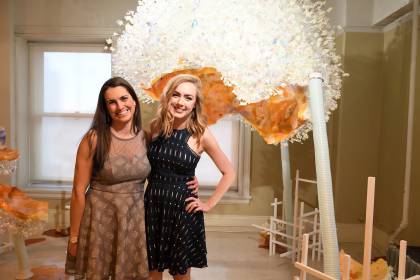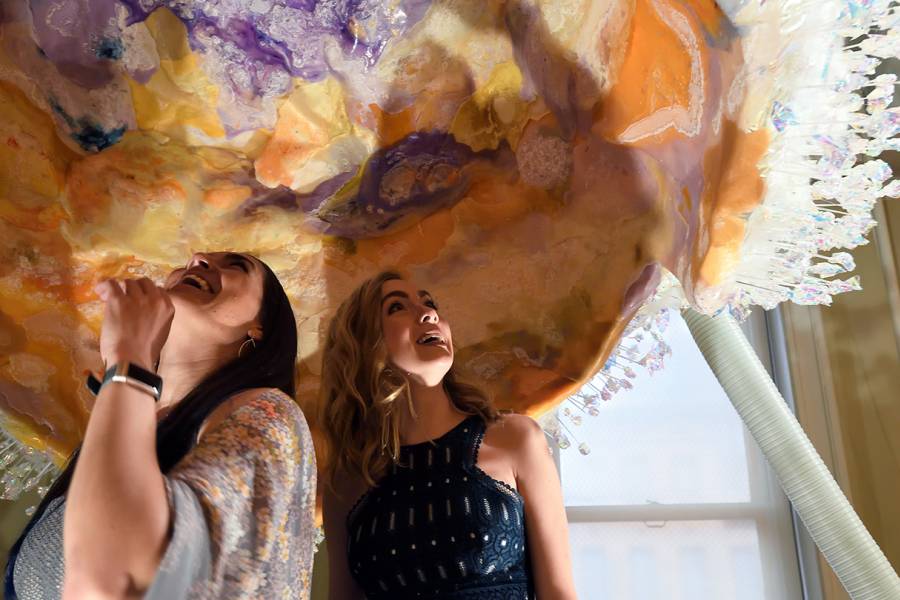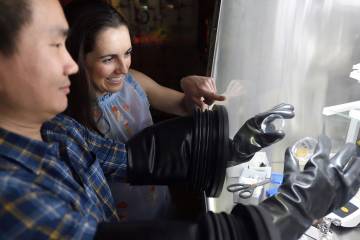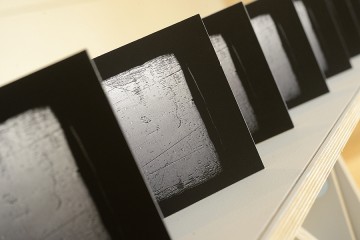Saturn's largest moon, Titan, is one of the outer solar system's most intriguing places. Though it has no liquid water on its surface, Titan boasts rivers and lakes of liquid methane and ethane, and its dense orange atmosphere gives it an ethereal appearance.
Though no human has set foot on that distant moon, an exhibit open now through Feb. 23 at the Bromo Seltzer Arts Tower in downtown Baltimore allows visitors to experience Titan's otherworldly appeal.

Image caption: Sarah Hörst (left) and Amy Wetsch
Image credit: Will Kirk / Johns Hopkins University
Featuring mixed-media sculptures, drawings, and large-scale installations, "Lateral Distance" was created by Amy Wetsch, a Maryland Institute College of Art graduate student who spent the summer in the laboratory of Johns Hopkins planetary scientist Sarah Hörst. The pair came together as part of the Hopkins Extreme Materials Institute's Extreme Arts Program, which connects scientists and engineers with MICA professors and students to explore their differing perspectives on extreme events and to find common ground.
An MFA candidate in MICA's Mount Royal School of Multidisciplinary Art, Wetsch found herself fascinated by Hörst's research, which concerns atmospheric chemistry and focuses on Titan.
"All of my work deals with thinking about and uncovering mysteries in various fields of science," she said. "When I first met Dr. Sarah Hörst, she told me about how she was simulating atmospheres to better understand Titan and uncover its mysteries. It was at that point that I knew I had to work with her and help her artistically visualize and simulate Titan's atmosphere."
Wetsch began her internship by immersing herself in the life of Hörst's laboratory in the Department of Earth and Planetary Sciences, attending lab group meetings, watching experiments, networking with collaborators at the Johns Hopkins Applied Physics Lab, and learning as much as she could about Titan and outer space. Then she got to work, mining the lab for interesting materials such as copper gaskets that can only be used once in a planetary haze research chamber, sand that was used in a Titan wind tunnel experiment, and old HVAC tubes. She then mixed glue, glycerin, iridescent film, salt, glass, cotton, and other materials to create a stunning, large-scale piece that fills a 450-square-foot room, as well as smaller mixed media sculptures aimed at capturing Titan's essence.
"This was the most exciting summer of my life," Wetsch said. "[As an artist, I found that] broadening your mind adds so much more depth to your work. My collaboration with Dr. Hörst is not going to stop after this; I hope our dialogue continues for years and years."
Hörst feels the same way.
"Having Amy with us was absolutely incredible," she said. "She caught on to the science so fast. Combining our scientific language with her artistic language gave us all a lesson in communication. People treat science and art as two different things. We use different words, but the concepts, philosophy, and thought processes are very similar."
Posted in Arts+Culture, Science+Technology
Tagged mica, johns hopkins extreme materials institute, sculpture, arts










